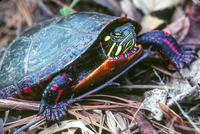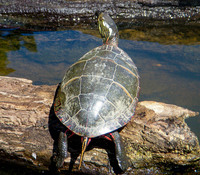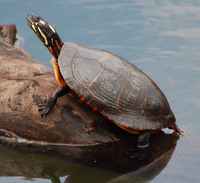Taxonomy
Class: ReptiliaOrder: TestudinesFamily: EmydidaeSubfamily: DeirochelyinaeOther Common Name(s): Northern Painted Turtle- Painted Turtle
Taxonomic Comments: Chrysemys is a purely North American genus, with two species currently recognized (SSAR, 2016). Only C. picta occurs in North Carolina.Species Comments: Three subspecies are currently recognized within Chrysemys picta , with only the nominate form believed to occur in North Carolina. Palmer and Braswell (1995), however, note that more surveys are needed in the mountains to determine if there is any intergradation with the Midwestern Painted Turtle (C. picta marginata ), which has been found to exist in eastern Tennessee.
Identification
Basis for Records: Good quality photographs, showing markings on the head or carapace, are usually sufficient for identification.Field Marks: Painted Turtles typically have two oval yellow spots on their heads and both yellow and red stripes on their necks. In Cooters and Yellow-bellied Sliders, the heads and necks have patterns of yellow stripes only, some of which may be widened to form blotches. Red-eared Sliders have a red stripe on the rear of their head but lack narrow red stripes on their necks. See subspecies account for details of the shell pattern found in C. p. picta .Morphological Features: According to Seidel and Smith (1986), the adult carapace in Chrysemys is smooth (without rugosities), unkeeled, not serrated or notched posteriorly. These features separate this genus from both Pseudemys and Trachemys , which have rugose, keeled, and posteriorly serrated shells. Chrysemys is further characterized by having the cervical scute frequently notched or projected and the first vertebral scute unconstricted anteriorly. The upper jaw is notched in front with small cusps on each side and inside the mouth, the alveolar surface of the upper jaw is narrow with a low median ridge, and the posterior palatine foramen is large. The lower jaw is relatively short and broad with a narrow alveolar surface.Technical Reference: Palmer and Braswell (1995); Ernst and Lovich (2009)Field Guide Descriptions: Beane et al. (2010); Powell et al. (2016)Online Photos: Google iNaturalist GBIF Observation Methods: Basking individuals are most the frequently spotted, although they will rapidly enter the water if a human observer is detected. Females may sometimes be detected as they move overland to their nesting sites.
Distribution in North Carolina
Distribution Comments: Painted Turtles occur across the state, from the low mountains to the Tidewater region. The highest elevation where this species has definitely been recorded is 2,598 ft (792 m). Records from the Outer Banks are largely missing although Parlin et al. (2019) recorded it at Nags Head Woods. Another large gap in the range of this species occurs in the southeast corner of the state, where the northern limits of this subspecies appears to have been reached, at least within the Coastal Plain (see range map in Powell et al., 2016).Distribution Reference: Palmer and Braswell (1995); NCMNS Herpetology Collection Database (accessed 2023-01)County Map: Clicking on a county returns the records for the species in that county.
Key Habitat Requirements
Habitat: Painted Turtles occur primarily in well-insolated ponds, lakes, sloughs, marshes and other still or slow-flowing freshwater habitats with soft bottoms and often with abundant aquatic vegetation (Palmer and Braswell, 1995; Ernst and Lovich, 2009).Environmental and Physiological Tolerances: The range of the Eastern Painted Turtle extends from Central North Carolina to Nova Scotia (Powell et al., 2016), indicating a fairly high tolerance for colder temperatures. Within North Carolina, this tolerance accounts for their occurrence from the Tidewater to at least the low mountains (<4,000').Adaptations to Natural Disturbances: This species is well-adapted to beaver-pond habitats, which undergo a natural cycle of succession and require periodic dispersal as the ponds fill in or are abandoned by the beavers. The felling of trees by beavers may be important for this species, increasing the insolation of the ponds and providing basking sites. Although this species can make long distance dispersal movements between habitats, particularly as their home ponds become less suitable, large die-offs have been observed as the apparent result of severe droughts that rapidly dry up their ponds (Ernst and Lovich, 2009).Biotic Relationships: Painted Turtles mainly carnivorous as hatchlings and juveniles but become omnivorous as they age. Ernst and Lovich (2009) list a number of small invertebrates that are used by the juveniles, including minute crustaceans such as cladocerans. A long list of plants are used by the adults, including algae and duckweed. Some fish and amphibians are also eaten but probably mainly as carrion. The reliance on plant material by the adults explains their preference for well-insolated, shallow ponds and oxbows.
Life History and Autecology
Breeding and Courtship: Males and females both take several years to reach sizes large enough for reproduction to take place; Ernst and Lovich (2009) mention 2-4 years for males and 6-10 years for females. Mating takes place in the spring, from March to mid-June, but with later dates also sometimes observed (Ernst and Lovich). As in other pond turtles, males courtship displays involve stroking the faces of females using their elongated front claws. Reproductive Mode: Nesting takes place from late May to July in North Carolina (Palmer and Braswell, 1995). Individual females can lay more than one clutch; Ernst and Lovich (2009) mention that two clutches may be the norm but that as many as five have been observed. Not all females lay every year, however. Although sex is determined by the temperatures eggs experience in the nest, females apparently do not choose nest sites that bias the sexes of their offspring (Ernst and Lovich). Nests are usually dug in sandy or loamy soils, often in open areas with a southern exposure (Ernst and Lovich). Females may return repeatedly to the same nesting sites. From 1-23 eggs may be laid per clutch (Ernst and Lovich); in North Carolina, 3-8 appear to be the norm (Palmer and Braswell). Hatchlings may remain in the nests over the winter.
General Ecology
Adverse Environmental Impacts
Status in North Carolina
NHP State Rank: S5Global Rank: G5
Photo Gallery for Chrysemys picta - Painted Turtle 44 photos are available. Only the most recent 30 are shown.
Recorded by: J. Mickey Recorded by: J. Reynolds Recorded by: Andrew W. Jones Recorded by: Jessica Tate Recorded by: Steve Hall Recorded by: R. Spainhour Recorded by: K. Sanford, A. Brown Recorded by: Joe Mickey Recorded by: J. Mickey Recorded by: Joe Mickey Recorded by: A. Ledford Recorded by: B. Anderson Recorded by: B. Anderson Recorded by: K. Sanford Recorded by: K. Sanford Recorded by: j.wyche Recorded by: j.wyche Recorded by: j.wyche Recorded by: j.wyche Recorded by: j.wyche Recorded by: j.wyche Recorded by: K. Bischof Recorded by: K. Bischof Recorded by: J. Mickey Recorded by: J. Williams Recorded by: J. Mickey Recorded by: j.wyche Recorded by: W. Stanley Recorded by: J. Wyche Recorded by: J. Mickey

 »
» 




 »
» 


